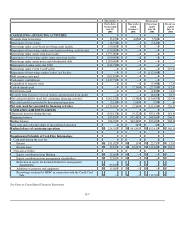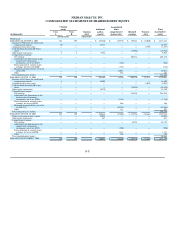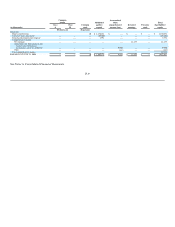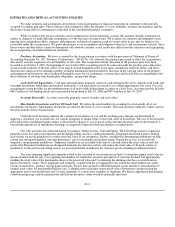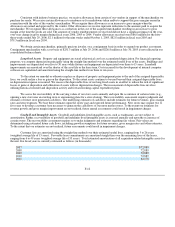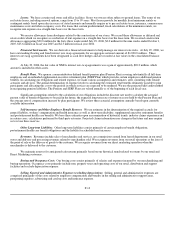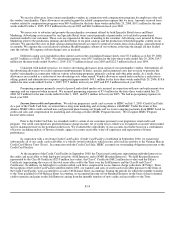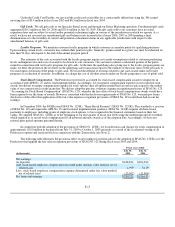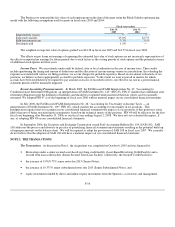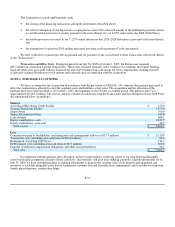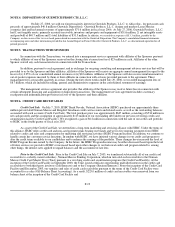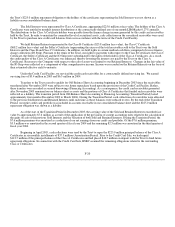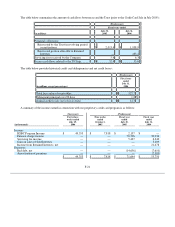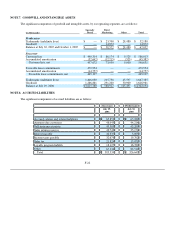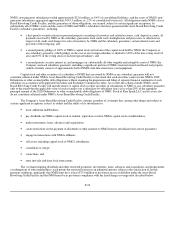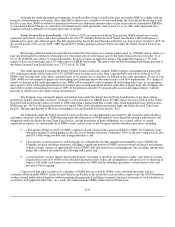Neiman Marcus 2005 Annual Report Download - page 94
Download and view the complete annual report
Please find page 94 of the 2005 Neiman Marcus annual report below. You can navigate through the pages in the report by either clicking on the pages listed below, or by using the keyword search tool below to find specific information within the annual report.
Under the Credit Card Facility, we serviced the credit card receivables for a contractually defined servicing fee. We earned
servicing fees of $5.4 million in fiscal year 2005 and $6.3 million in fiscal year 2004.
Gift Cards. We sell gift cards at our Specialty Retail stores and through our Direct Marketing operation. Unredeemed gift cards
aggregated $30.1 million at July 29, 2006 and $25.6 million at July 30, 2005. The gift cards sold to our customers have no stated
expiration dates and are subject to actual and/or potential escheatment rights in various of the jurisdictions in which we operate. As a
result, we have not reversed any unredeemed gift card balances into income in fiscal years 2006, 2005 or 2004 pending a final
determination as to the invalidity of current and potential escheatment claims in any applicable jurisdictions with respect to the
unredeemed balances of gift cards.
Loyalty Programs. We maintain customer loyalty programs in which customers accumulate points for qualifying purchases.
Upon reaching certain levels, customers may redeem their points for gifts. Generally, points earned in a given year must be redeemed no
later than 90 days subsequent to the end of the annual program period.
The estimates of the costs associated with the loyalty programs require us to make assumptions related to customer purchasing
levels, redemption rates and costs of awards to be chosen by our customers. Our customers redeem a substantial portion of the points
earned in connection with our loyalty programs for gift cards. At the time the qualifying sales giving rise to the loyalty program points are
made, we defer the portion of the revenues on the qualifying sales transactions equal to the estimate of the retail value of the gift cards to
be issued upon conversion of the points to gift cards. We record the deferral of revenues related to gift card awards under our loyalty
programs as a reduction of revenues. In addition, we charge the cost of all other awards under our loyalty programs to cost of goods sold.
Stock-Based Compensation. The Predecessor previously accounted for stock-based compensation awards to employees in
accordance with APB No. 25 and its related interpretations. Accordingly, we recognized compensation expense on our restricted stock
awards but did not recognize compensation expense for stock options since all options granted had an exercise price equal to the market
value of our common stock on the grant date. We did not adopt the previous voluntary expense recognition provisions of SFAS No. 123,
"Accounting for Stock-Based Compensation" (SFAS No. 123), whereby the fair value of stock-based compensation awards would have
been expensed over the terms of awards. However, consistent with the disclosure requirements of SFAS No. 123, we made pro forma
disclosures of the effect that application of the fair value expense recognition provisions of SFAS No. 123 would have had on our net
earnings.
In December 2004, the FASB issued SFAS No. 123(R), "Share-Based Payment" (SFAS No. 123(R)). This standard is a revision
of SFAS No. 123 and supersedes APB No. 25 and its related implementation guidance. SFAS No. 123(R) requires all share-based
payments to employees, including grants of employee stock options, to be recognized in the financial statements based on their fair
values. We adopted SFAS No. 123(R) as of the beginning of our first quarter of fiscal year 2006 using the modified prospective method,
which required us to record stock compensation for all unvested and new awards as of the adoption date. Accordingly, we have not
restated prior period amounts presented herein.
In connection with the adoption of the provisions of SFAS No. 123(R), we recorded non-cash charges for stock compensation of
approximately $20.0 million in the period from July 31, 2005 to October 1, 2005 primarily as a result of the accelerated vesting of all
Predecessor options and restricted stock in connection with the Transactions (see Note 2).
The following table illustrates the pro forma effect on net earnings for periods prior to the adoption of SFAS No. 123(R) as if the
Predecessor had applied the fair value recognition provisions of SFAS No. 123 during fiscal years 2005 and 2004:
Fiscal years ended
(in thousands)
July 30,
2005
July 31,
2004
Net earnings:
As reported $ 248,824 $ 204,832
Add: stock-based employee compensation recorded under intrinsic value method, net of
related taxes 4,999 3,119
Less: stock-based employee compensation expense determined under fair value method,
net of related taxes (13,302)(11,806)
Pro forma net earnings $ 240,521 $ 196,145
F-15




